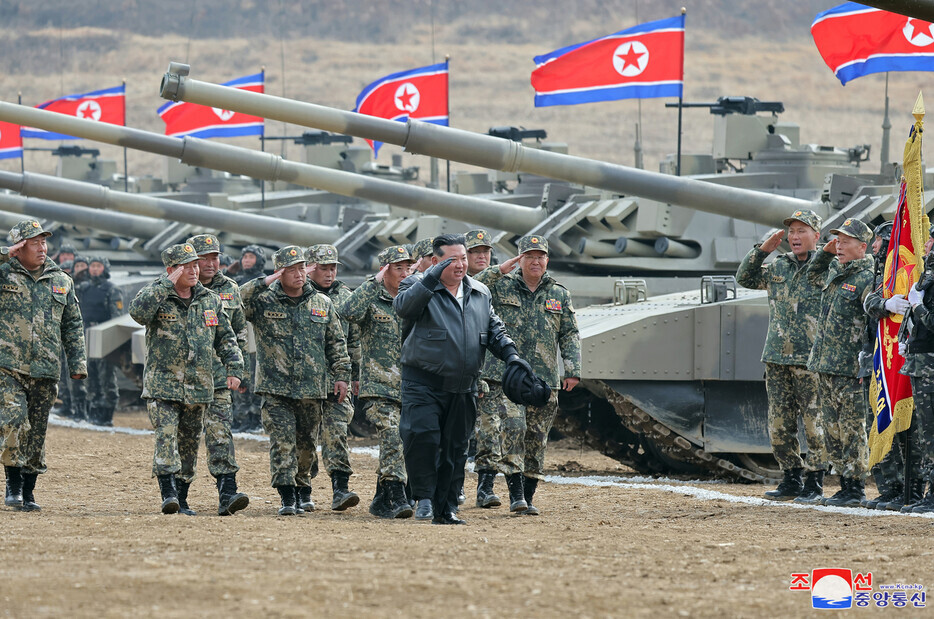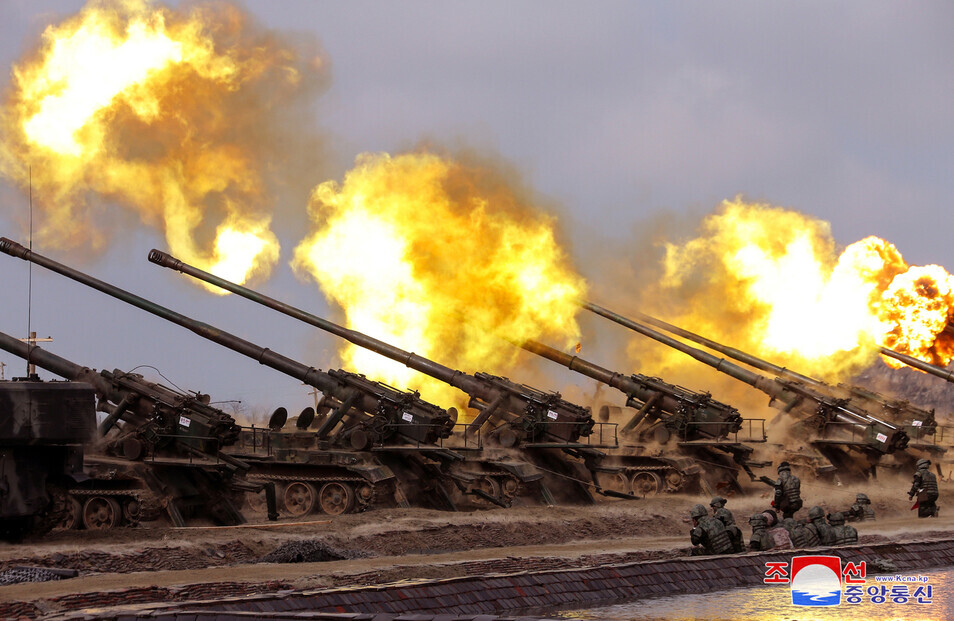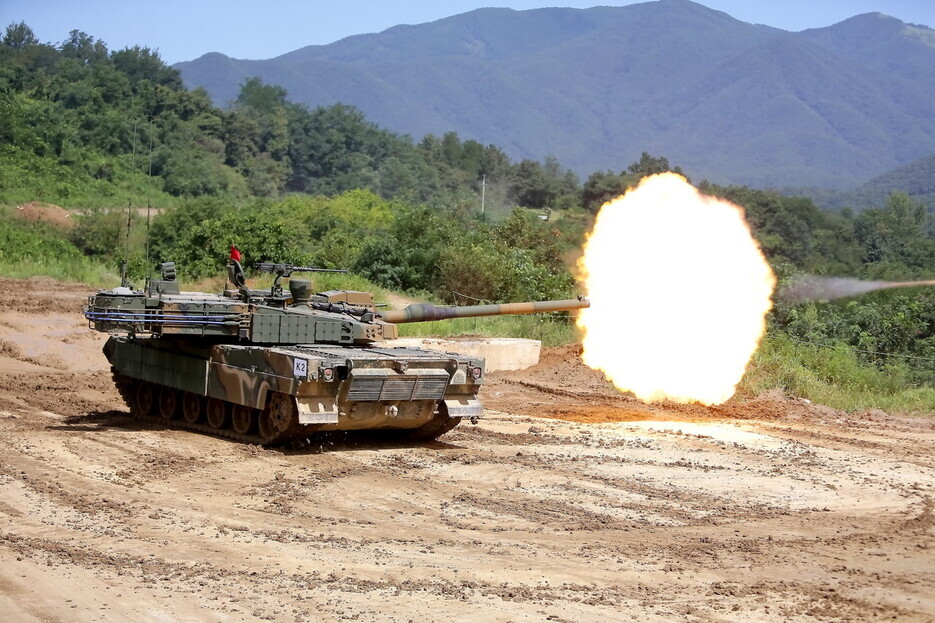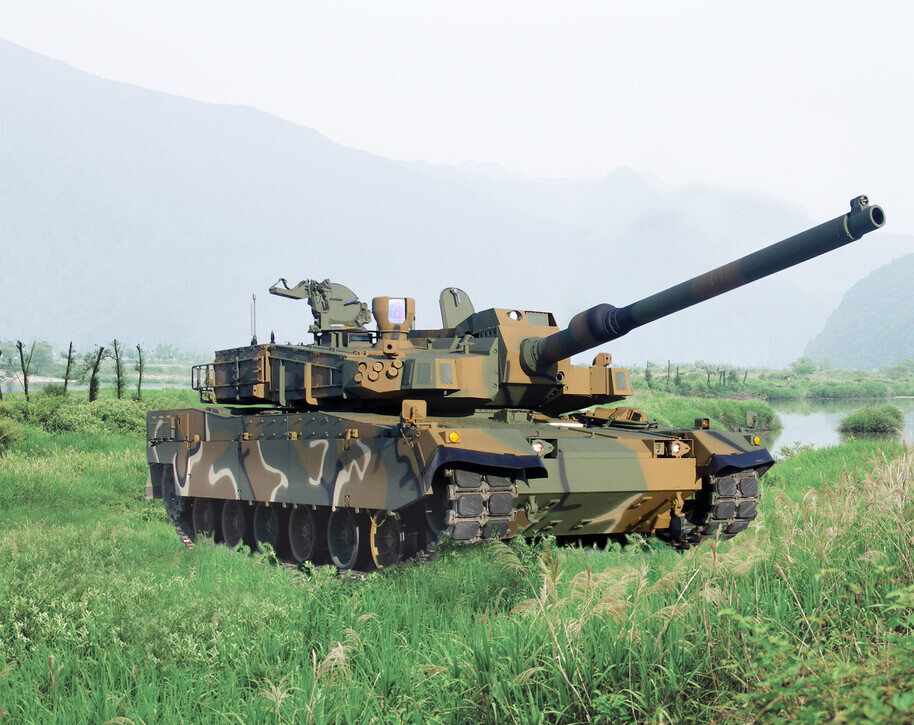hankyoreh
Links to other country sites 다른 나라 사이트 링크
Is Kim Jong-un’s boast about having ‘most powerful tanks in the world’ more than wishful thinking?

North Korean leader Kim Jong-un personally oversaw five military drills targeting South Korea in March alone, all in response to the joint Freedom Shield exercises by the South and the US, which took place on March 4-14.
North Korea chose to escalate the drills gradually over five sessions. On March 6, a major operational training base of the Korean People’s Army in western North Korea conducted a drill targeting front-line South Korean guard posts, while combined units of the KPA conducted an artillery firing drill simulating the bombardment of the Seoul metropolitan area a day later.
On March 13, a training match between tank units simulated the capture of Seoul, airborne units trained to target the rear of South Korea on March 15, and the salvo drill of a firepower sub-unit utilizing super-large multiple rocket launchers on March 18 played out the capture of Seoul and the collapse of the South Korean military.
The drills were designed to simulate the outbreak of a real war on the Korean Peninsula, in which North Korea would attack South Korean military surveillance posts near the armistice line, use artillery to bombard the greater Seoul area to break down South Korean defenses to open the way for tank units to break through the front lines, expand their forces, and drive toward Seoul.
North Korean airborne forces would then infiltrate the South Korean rear to stir up chaos and unrest, while super-large multiple rocket launchers would level key facilities in Seoul.

The North Korean military has been training for this specific scenario since Kim said at a key meeting of the Workers’ Party of Korea on Dec. 30, 2023, that he would “put continuous spurs to the preparations for a great event to suppress the whole territory of south Korea by mobilizing all physical means and forces.”
These military drills seem to be a demonstration of the North Korean military’s confidence that it can overwhelm South Korea not only with nuclear weapons, but also with conventional forces such as artillery and tanks.
In particular, Kim’s guidance of the tank unit’s training on March 13 drew much attention due to the fact that Kim himself drove one of North Korea’s new tanks.
The state-run Rodong Sinmun reported, “[Kim] expressed great satisfaction over the fact that the new-type main battle tank successfully demonstrated its very excellent striking power and mobility, displaying its amazing combat capability for the first time in the tankmen’s match. He said it is something we can be proud of that the KPA is equipped with the most powerful tanks in the world.”
This “new-type main battle tank” was first unveiled in October 2020 during a military parade to commemorate the 75th anniversary of the founding of the Workers’ Party of Korea, and its latest appearance shows that it has been deployed in action.
The Seoul Ryu Kyong Su Guards 105th Tank Division also attended the training.
Kim praised the particular division for being “a unit with the proud history and tradition of having occupied the enemy capital.”
“If all the units and subunits of the entire army are well prepared like the subunits of the 105th Tank Division which participated in the match, he would never worry about the preparations for war,” Kim said, according to the Rodong Sinmun.
The 105th Tank Division was the first North Korean tank unit to break through Seoul’s defenses to capture the city during the Korean War. While it was originally a sub-unit to the 9th Tank Brigade, it was promoted to the 105th Tank Division for being the key force in the capture of Seoul. The words “guard” and “Seoul” were later added to its title to flaunt the fact that it once captured the South’s capital.
Later, the name of the division’s commander, Ryu Kyong-su, was added to its title, giving it the full name of “Seoul Ryu Kyong Su Guards 105th Tank Division.”
The name of this unit recalls South Korea’s trauma of losing Seoul to North Korean tanks during the Korean War.


But should we take Kim’s boasts of the new North Korean tanks being “the most powerful tanks in the world” at face value? It’s undeniable that their offensive and defensive capabilities have been significantly elevated compared to previous North Korean tanks.
In comparison with previous models, this latest one is shorter in height and has a longer body. It is equipped with an active protection system (APS) to intercept missiles and shells approaching it. This design method, which enhances the tank’s defense and survival capabilities, has already been adopted for new tank models in South Korea, the US, Russia and China.
The new North Korean tank has an anti-tank missile attached to the right of its turret — a feature rarely found in modern tanks.
Shin Seung-ki, a research fellow at the Korea Institute for Defense Analyses, said, “This suggests a strong possibility that the new North Korean tank’s effective gun range and penetrative capabilities are inferior to those of the main South Korean tanks such as the K2 Black Panther, or that the front turret passes within the effective gun range of the major South Korean tanks.”
The analysis was that because the new North Korean tanks have inferior armor defense capabilities and destructiveness compared to the main South Korean tanks — which puts them at a disadvantage in combat where the tanks are within each other’s effective firing range — additional anti-tank missiles were included to carry out attacks outside that range.

[%%IMAGE4%%]
Analysts also said the new North Korean tanks were likely to face fuel shortages in actual combat situations due to North Korea’s economic difficulties and sanctions.
Ken Gause, the research program director at the US Center for Naval Analyses, was quoted by Radio Free Asia as saying in a March 14 telephone interview that the biggest problem the North Korean tanks would face would be obtaining the fuel needed to travel long distances.
He also predicted that because North Korea was likely to not have adequate fuel, the tanks would be restricted to defensive activities that do not require a lot of movement.
In the military world, it is said that “operations win battles and armaments win wars.”
For equipment to do its job on the battlefield, fuel is essential. Tank fuel has a direct bearing on mobility and combat capabilities — and tanks are notorious gas-guzzlers.
The major tanks used by countries around the world have mileage on the order of 200–400 meters per liter of fuel. That number is even lower in real combat situations. According to witnesses, the 63-ton US M1A2 tank operated at 50 meters per liter during the Gulf War.
With the combined effects of sanctions and economic struggles, North Korea faces difficulties acquiring fuel. South Korean and US intelligence authorities believe that in the event of a full-scale war, the destruction of oil storage facilities by South Korean and US attacks would reduce the North Korean military’s activities to a very limited scope.
In 2006 — before the current economic sanctions against North Korea took full effect — the US-based Nautilus Institute for Security and Sustainability released results from a simulation of the North Korean military’s wartime fuel supply capabilities. It predicted that North Korean air operations would no longer be possible within 24 hours of hostilities commencing, with naval warship activities halted within five days and two-thirds of the North Korean military’s equipment ceasing to operate as fuel reserves run out.
Concluding that North Korea’s energy situation prevents it from waging a long-term war, the institute predicted that any war that erupts would reach a conclusion quickly.
In light of the new tanks’ performance and North Korea’s war prosecution capabilities, Kim Jong-un’s hopes of boasting the world’s “most powerful tanks” appear for the moment to be mostly wishful thinking.
By Kwon Hyuk-chul, staff reporter
Please direct questions or comments to [english@hani.co.kr]

Editorial・opinion
![[Column] Season 2 of special prosecutor probe may be coming to Korea soon [Column] Season 2 of special prosecutor probe may be coming to Korea soon](https://flexible.img.hani.co.kr/flexible/normal/500/300/imgdb/original/2024/0426/3317141030699447.jpg) [Column] Season 2 of special prosecutor probe may be coming to Korea soon
[Column] Season 2 of special prosecutor probe may be coming to Korea soon![[Column] Park Geun-hye déjà vu in Yoon Suk-yeol [Column] Park Geun-hye déjà vu in Yoon Suk-yeol](https://flexible.img.hani.co.kr/flexible/normal/500/300/imgdb/original/2024/0424/651713945113788.jpg) [Column] Park Geun-hye déjà vu in Yoon Suk-yeol
[Column] Park Geun-hye déjà vu in Yoon Suk-yeol- [Editorial] New weight of N. Korea’s nuclear threats makes dialogue all the more urgent
- [Guest essay] The real reason Korea’s new right wants to dub Rhee a founding father
- [Column] ‘Choson’: Is it time we start referring to N. Korea in its own terms?
- [Editorial] Japan’s rewriting of history with Korea has gone too far
- [Column] The president’s questionable capacity for dialogue
- [Column] Are chaebol firms just pizza pies for families to divvy up as they please?
- [Column] Has Korea, too, crossed the Rubicon on China?
- [Correspondent’s column] In Japan’s alliance with US, echoes of its past alliances with UK
Most viewed articles
- 1‘We must say no’: Seoul defense chief on Korean, USFK involvement in hypothetical Taiwan crisis
- 2Is Japan about to snatch control of Line messenger from Korea’s Naver?
- 3Division commander ordered troops to enter raging flood waters before Marine died, survivor says
- 4[Editorial] Korea’s surprise Q1 growth requires objective assessment, not blind fanfare
- 5[Column] Season 2 of special prosecutor probe may be coming to Korea soon
- 6[Special report- Part III] Curses, verbal abuse, and impossible quotas
- 7Flying “new right” flag, Korea’s Yoon Suk-yeol charges toward ideological rule
- 8[Guest essay] The real reason Korea’s new right wants to dub Rhee a founding father
- 9[Column] ‘Choson’: Is it time we start referring to N. Korea in its own terms?
- 10[Column] Park Geun-hye déjà vu in Yoon Suk-yeol